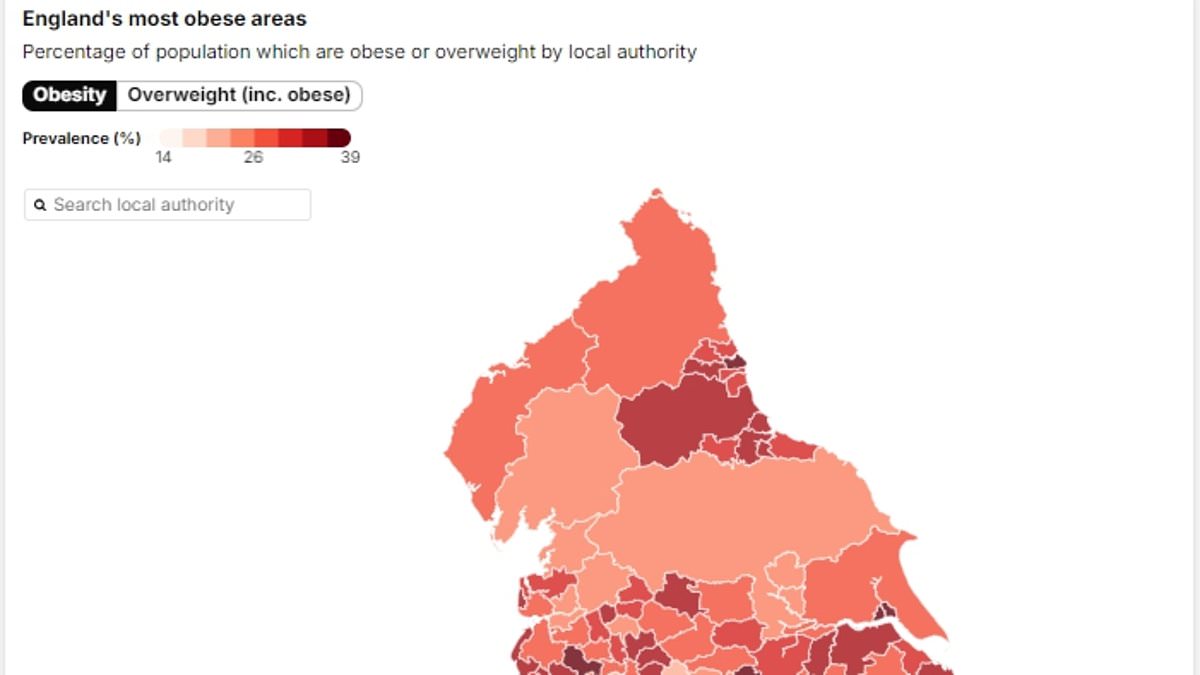England’s fattest areas where nearly 80 per cent of people are overweight have been revealed.
In places with the highest rates of overweight people as many as 34 per cent of the population are classed as clinically obese, sobering figures show.
It comes as the NHS struggles to cope with the intensifying crisis which sees thousands of hospital admissions from conditions that are related to being overweight every single day.
Diabetes, heart disease, breathing issues, strokes and mental health problems are just some of the illnesses associated with being overweight.
The government has previously said that obesity alone costs the NHS £6.5billion every year, with the condition being the second biggest preventable cause of cancer.
One health expert told that ‘drastic measures’ are needed to halt the increase and to combat the effect this is having on our society.
The map below shows what percentage of people are obese and overweight in England.
Speaking exclusively to Professor Alex Miras, an obesity expert at Ulster University, shed some light on why he thinks the crisis has escalated and what he thinks can be done about it.
County Durham takes the crown for the fattest area in Britain with 77.7 per cent cent of its residents being overweight and 34 per cent being obese.
Following closely behind is the Metropolitan borough of Wirral near Merseyside where the obesity rate is almost 36 per cent while 76.3 per cent are overweight.
Third place on the alarming list goes to the district of Cannock Chase, Staffordshire, where over 38.4 per cent of its 100,000 strong population are obese and 76 per cent overweight.
Meanwhile Wigan has the highest rate of clinically obese people as opposed to overweight with 39.1 per cent of its population being obese while 70.8 per cent are overweight.
Obesity is classified as an excessive fat accumulation that presents a risk to health with a BMI of over 30.
A BMI of more than 25 is considered overweight but not obese.
On the other end of the scale the skinniest area is the famously affluent Borough of Kensington and Chelsea where just 46 per cent are overweight and only 13 per cent classified as obese.
Prof Miras explained how he thinks ‘drastic measures’ are required to stop the obesity crisis.
He thinks deprivation is ‘the strongest’ factor in the equation but education also plays a part.
He said: ‘It’s very much multi-factorial. So people in areas of deprivation work very long hours.
‘They have got very limited time to look after themselves. Very limited time to look after their children and family.
‘They are likely to resort to cheaper food and unfortunately these days cheaper food tends to be more unhealthy food.’
Prof Miras added: ‘Usually lower education status is associated with lower socioeconomics and it means that people just haven’t had the education of what to choose in terms of what to eat, what to avoid, what is healthy, what is not healthy.
The professor stressed that there would be no quick fix to tackle the problem but suggested local authorities could consider limiting the number of take away restaurants in an area.
He said: ‘If you want to improve and reverse the situation, then you need to have much more drastic measures in terms of reversing deprivation.
‘This could mean improving access to healthier food, reducing the number of takeaways in the local area, increasing people’s physical activity, giving people more time to look after themselves.
‘So it’s not easy.’
